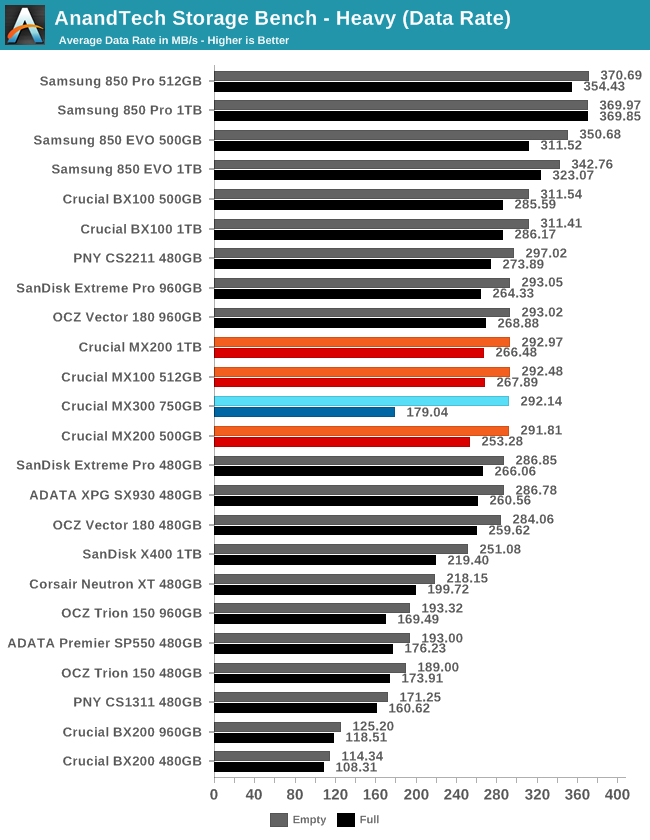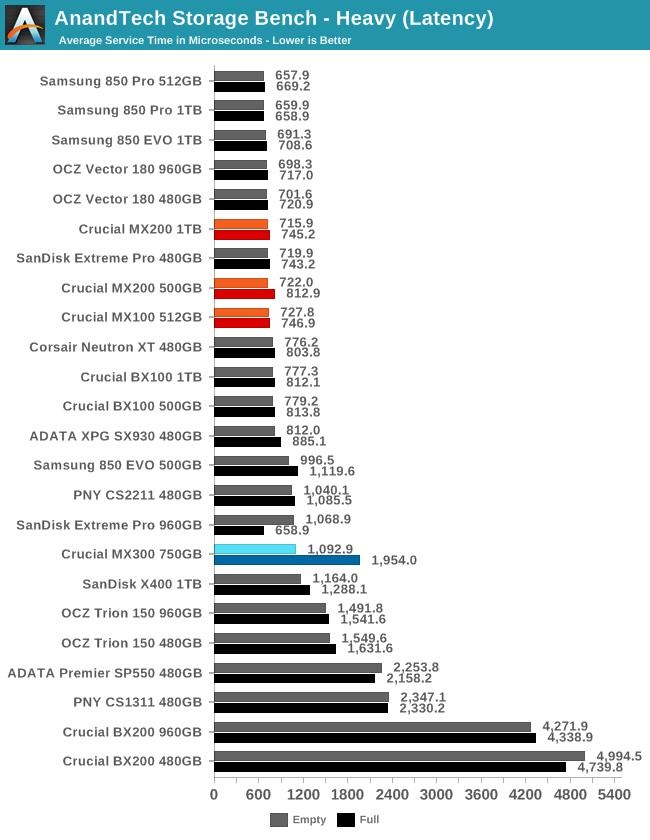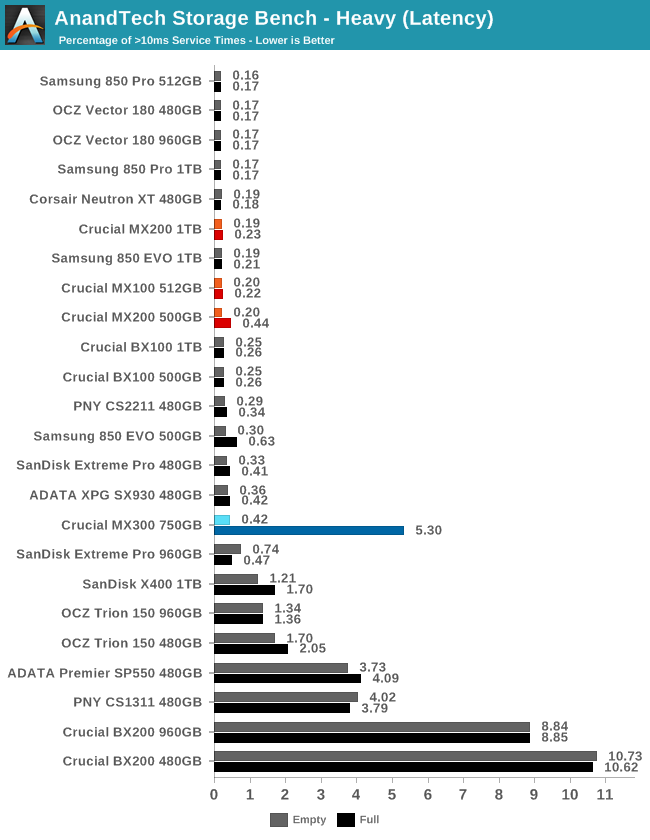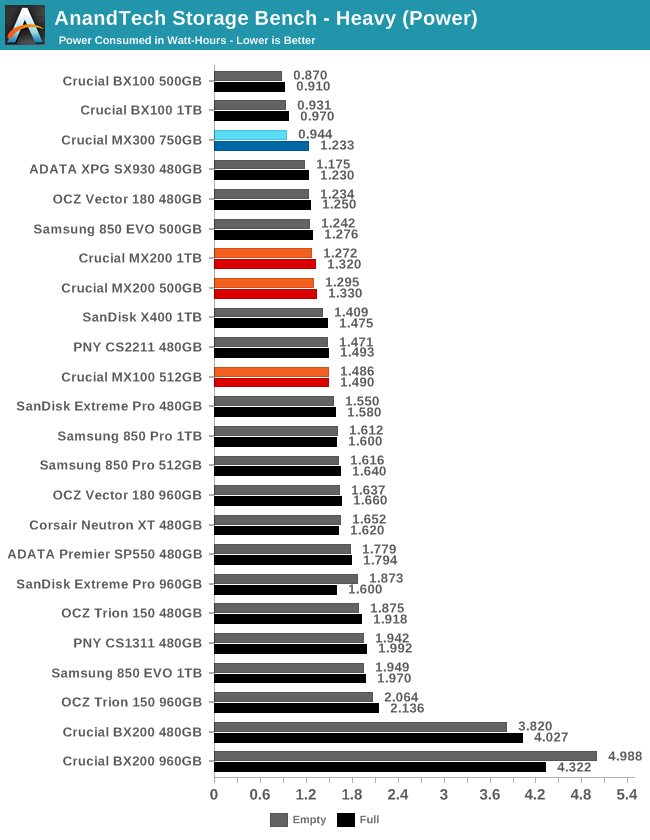The Crucial MX300 750GB SSD Review: Micron's 3D NAND Arrives
by Billy Tallis on June 14, 2016 9:00 AM ESTAnandTech Storage Bench - Heavy
Our Heavy storage benchmark is proportionally more write-heavy than The Destroyer, but much shorter overall. The total writes in the Heavy test aren't enough to fill the drive, so performance never drops down to steady state. This test is far more representative of a power user's day to day usage, and is heavily influenced by the drive's peak performance. The Heavy workload test details can be found here.

The average data rate of the MX300 is virtually identical to that of its predecessors, except that when full the MX300's identity as a TLC drive is revealed by a precipitous drop.

The average service time of the MX300 when running the test on an empty drive places the MX300 between the slow MLC drives and the fast planar TLC. When the test is run on a full drive the average service time grows to be close to that of some of the cheapest drives on the market.

When run on an empty drive, the write-oriented Heavy test doesn't produce a significant number of latency outliers, but on a full drive delays are quite common.

The MX300's power efficiency is once again very close to the top of the charts, even for the full-drive test.










85 Comments
View All Comments
Impulses - Wednesday, June 15, 2016 - link
Most users are still served fine by lower cost SATA drives and they'll probably remain common for years to come... And nobody is using SATA Express, wouldn't be surprised if it disappears from mobos, stillborn interface.M.2/PCI-E vs SATA is almost like 7,200+ RPM vs 5,400 RPM at this point.
Adam-James - Thursday, June 16, 2016 - link
"And nobody is using SATA Express..."That's part of the problem. Why is this a state of affairs that we're OK with? To me, the fact that no manufacturer has yet released, or has future plans to release, a SATA Express drive is infuriating, and even more so when they continue to put out AHCI SATA drives. That every flash manufacturer is so satisfied with the status quo and uninterested in improving the technology they sell is outrageous. And they're following the same pattern with U.2 - I've read about at least one executive who had the gall to claim his company wasn't adopting it for their SSD line because consumers "aren't interested." The industry might be satisfied with mediocrity, but we shouldn't be.
Impulses - Friday, June 17, 2016 - link
I don't think it's about mediocrity on the manufacturer's party... It's just a mediocre interface. M.2/U.2 are far better suited for next gen drives, and if you don't need that kinda performance (and most people don't) then SATA is fine. SATA Express represents an awkward middle ground that would potentially bottleneck next gen PCI-E/M.2 drives, so it seems the industry just said "why bother?".KAlmquist - Wednesday, June 15, 2016 - link
1. Samsung's accomplishment with the 850 EVO looks even better today. I was expecting that the Intel/Micron product would be as good as the Samsung 3D NAND when it finally came to market. But it appears that the 1.5 year old Samsung 3D TLC NAND is faster than the 3D TLC NAND that Intel/Micron has just introduced.2. Fifteen months ago we were hearing claims that Intel/Micron 3D NAND would have "disruptive pricing." Currently, the 750GB MX300 sells for its list price of $200. Last October, hypothetical 750GB BX-100 SSD would have cost $232. (This price is computed by averaging the price of the 500GB and 1TB models.) That's a 14% price decrease over eight months, which is significant, but hardly "disruptive." Perhaps we will see some aggressive pricing in the future, once production ramps up, but for now "disruptive pricing" isn't happening.
We can hope that Toshiba/SanDisk 3D NAND (which should appear this year) will prove more exciting. There's also SK Hynix, which as far as I know is currently using its 3D NAND only in enterprise products.
Impulses - Wednesday, June 15, 2016 - link
Indeed.ST33LDI9ITAL - Friday, June 17, 2016 - link
Name other SSD's at this price point that also have power protection and full encryption/edrive support....ST33LDI9ITAL - Sunday, June 19, 2016 - link
Exactly... it's not all about performance... features matter too. This drive has good performance, good feature set, and good prices. It is an all around great mainstream drive.dananski - Friday, June 17, 2016 - link
Makes me so glad to have gotten a BX100 when they came out. Why can't they pull off something like that again? The budget drive that competed with Samsung on general performance and beat everything on power consumption.ZapNZs - Sunday, June 19, 2016 - link
Are the endurance specs correct? It seems unlikely the TLC in the MX300 will be anywhere near the MX200, even regardless of capacity differences.Billy Tallis - Tuesday, June 21, 2016 - link
Yes, the endurance specs are correct. I can't say for sure that the MX300 specs are equally conservative as the MX200 specs, but the whole point of 3D NAND is to enable a return to larger memory cells that are more like the ones from the early days of the SSD revolution, where even tiny drives had high endurance ratings because they had P/E cycle ratings that were five or six digits long instead of three or four. 3D NAND makes it possible to have big memory cells and still have a lot of them on one chip.